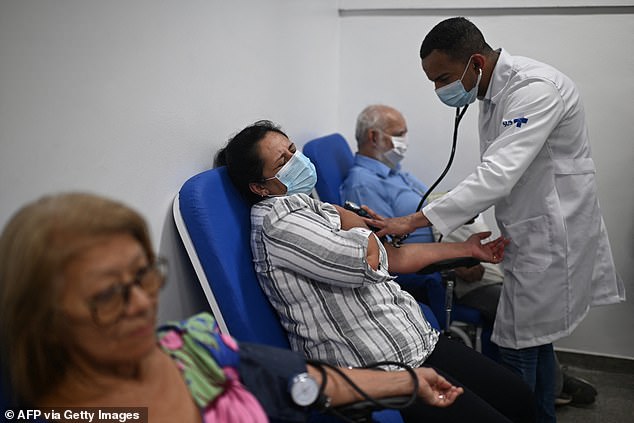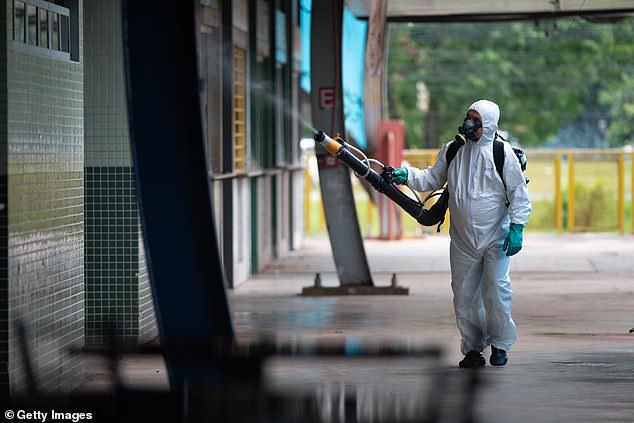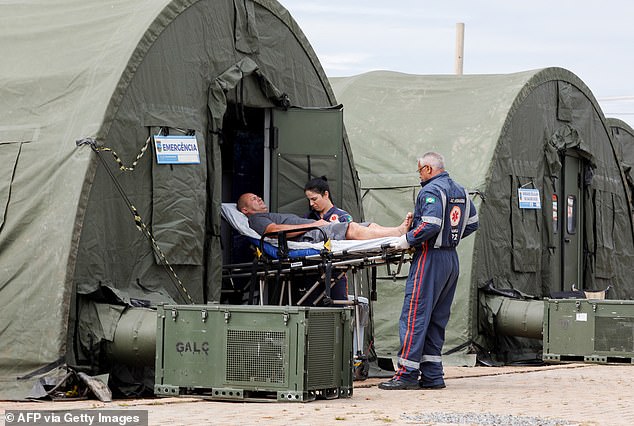Dengue fever is rampant across most of South America, forcing patients to languish on hospital floors as doctors are overwhelmed.
Brazil has recorded more than 1.5 million cases and 390 deaths from the disease this year alone, fast approaching the 1.6 million total cases confirmed throughout 2023.
And other countries on the continent, including Peru, Paraguay and Argentina, are struggling to keep up with the widespread outbreaks.
Doctors and patients in the capital Brasilia say it is creating scenes similar to the darkest days of Covid. Patients with the disease dubbed ‘bone-breaking disease’ due to the excruciating pain it causes in joints and bones can be heard wailing as overwhelmed doctors struggle to keep up with demand.
Epidemiologists blame the global rise in temperatures, which allow the mosquitoes that carry the virus to live longer and thrive over a wider range of territory.

Hospitals have been overrun, forcing patients to wait for care on floors or in wheelchairs


Brazilian officials have begun disinfecting the streets of major cities and hunting the mosquitoes that transmit dengue
That has prompted state health officials to roam 17 cities, declaring states of emergency, disinfecting properties and advising people on how best to avoid infection.
The CDC has issued a warning about the increasing number of cases.
Gabriela Paz-Bailey, who specializes in dengue at the CDC, said: ‘Dengue cases are increasing at an alarming rate.
‘It’s becoming a public health crisis and coming to places that have never had it before.’
There is a risk that what is happening in South America could also happen in the US, across much of the South, and much of Europe as temperatures continue to rise.
Florida reported a record 178 cases of local transmission last year. Hawaii, Texas, Arizona, and California have also reported community-level spread.
Albert Ko, an epidemiologist at Yale University, said: ‘There hasn’t been widespread transmission in the US, but that could change.
“We should be concerned that a major epidemic season in Brazil and the rest of South America will drive spread and transmission to places in the United States.”
Meanwhile, hospital beds have run out across Brazil.
Loide Rocha dos Santos, 57, went to an overcrowded hospital last month and sensed the chaos immediately.
Dengue had reduced her platelet count to a dangerously low level, but the Gama Region Health Clinic could do little to accommodate her, according to Washington Post.
She said: ‘The first two days I had to be in a wheelchair. They didn’t have a bed for me.’


Field hospitals located in strategic locations around Brazilian cities have struggled to keep up with the number of people needing care
Dengue, nicknamed the ‘bone-breaking disease’ for causing joint and muscle pain so severe it feels like the bones are breaking, is a virus that typically runs its course and goes away. But in as many as one in 20 cases, it can lead to bleeding and organ failure.
It usually causes a range of flu-like symptoms such as fever, headache, pain, nausea, swelling and rash for one to two weeks, but it can develop into a serious and fatal infection.
While cases and deaths in Brazil are skyrocketing, Peru is experiencing a similarly large outbreak, with 32 deaths and 31,000 infections in the first two months of 2024 alone. increase of 97 per cent in the same period last year.
The situation has become so serious that even tent hospitals have been erected in Brasilia and other cities in strategic locations to triage patients with the virus.
Paraguay and Argentina have recorded more than 5 times the typical number of cases so far this year, with more than 150,000 and 57,000 casesrespectively.
The eruptions in South America, which is currently experiencing the end of its summer season, may be a bellwether of what may come in the Northern Hemisphere.
Rising temperatures colliding with the El Nino phenomenon that brings intense rains have turned some countries into an oven for mosquitoes to thrive.
Thais dos Santos, a regional adviser on mosquito-borne viruses at the Pan American Health Organization, said: ‘Arboviral diseases are these viruses that are transmitted by mosquitoes and are a really excellent sentinel for the impact of climate change and human health.’
Aedes aegypti thrives in tropical, subtropical and temperate climates. Warmer temperatures over longer hot seasons mean mosquitoes can live longer, even by just a few days, driving things up.
Ms dos Santos added: ‘The warmer temperatures clearly allow the conditions for better transmission of these viruses.
“What we see is longer transmission periods. We see that the virus is being transmitted in areas that we had not seen before.’

